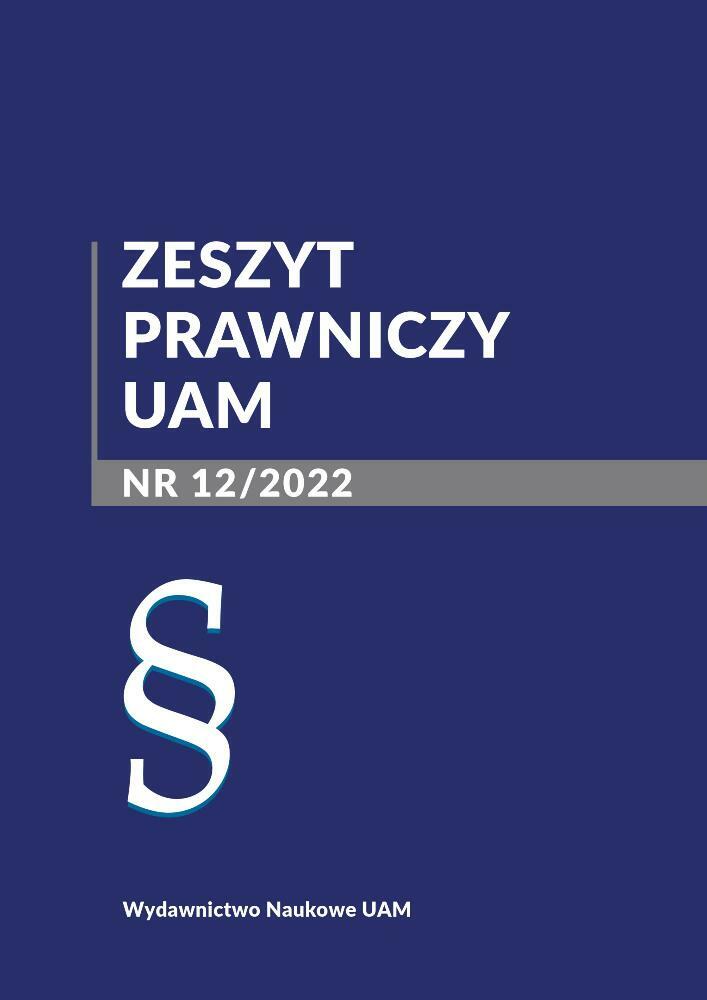Abstract
The purpose of this article is to present the problem of connecting the testator’s habitual residence on the grounds of the succession regulation (EU) No 650/2012. Particular attention is given to the question of the admissibility of a testator having more than one habitual residence at the moment of death. The background of the considerations made is the ruling of the Court of Justice of the European Union of July 16, 2020 (file C-80/19). The author juxtaposes the contradictory views of doctrine in the area being discussed, and also analyses the theses resulting from the judgment of 16 July 2020 in the context of the succession regulation no 650/2012.
References
Dörner, H. (2010). EuErbVO: Die Verordnung zum Internationalen Erbund Erbverfahrensrecht ist in Kraft!. Zeitschrift für Erbrecht und Vermögensnachfolge 10: 505-510.
Greeske, M. (2014). Die Kollisionsnormen der neuen EU-Erbrechtsverordnung. München. DOI: https://doi.org/10.3726/978-3-653-04383-9
Jaffey, A.J.F. (2002). Introduction to the Conflict of Law. Canada.
Köhler, A. (2017). [w:] W. Gierl, A. Köhler, L. Kroiß, H. Wilsch (red.), Internationales Erbrech EuErbVO| IntErbRVG | DurchfVOt. Baden-Baden.
Kränzle, M. (2016). The notion of habitual residence in recitals no 23 and 24 of the Succession Regulation, [w:] S. Bariatti, I. Viarengo, F. Villata (red.), Towards the entry into force of the Succession
Regulation: Building future uniformity upon past divergencies. JUST/2013/JCIV/AG/4666. Final Study: 165-196. http://www.dirittopubblico.unimi.it/extfiles/unimidire/389501/attachment/final-study-justt-2013-jciv-ag-4666-last-version.pdf [dostęp: 26.03.2022].
Lagarde, P. (2015). Commentary to art. 21, [w:] U. Bergquist et al., EU Regulation on Succession and Wills. Commentary. Köln: 119-183.
Margoński, M. (2018). Komentarz do art. 21, [w:] K. Osajda (red.), Komentarze prawa prywatnego, t. IVB: Prawo i postępowanie spadkowe. Komentarz. Warszawa: 26-31.
Mączyński, A. (1978). Zamieszkanie jako podstawa łącznika normy kolizyjnej. Zeszyty Naukowe Uniwersytetu Jagiellońskiego 81: 53-59.
Mączyński, A. (2008). Statut personalny osób fizycznych. Refleksje de lege lata i de lege ferenda, [w:] W. Uruszczak, P. Święcicka-Wystrychowska, A. Kremer (red.), Leges Sapere. Studia i prace dedykowane Profesorowi Januszowi Sondlowi w pięćdziesiątą rocznicę pracy naukowej, Kraków: 309-327.
Mączyński, A. (2009). Kodyfikacyjne zagadnienia części ogólnej prawa prywatnego międzynarodowego, [w:] A. Janik (red.), Studia i rozprawy. Księga jubileuszowa dedykowana profesorowi Andrzejowi Całusowi. Warszawa: 409-445.
Nowak, F. (2022). Miejsce zwykłego pobytu (zmarłego) jako łącznik kolizyjny w sprawach spadkowych. Monitor Prawniczy 4: 208-215.
Odersky, F. (2015). Commentar to art. 4, [w:] U. Bergquist et al. EU Regulation on Succession and Wills. Commentary. Köln: 64-119.
Odersky, F. (2016). Kommentar zur art. 21, [w:] R. Geimer, R. Schütze (red.), Europäische Erbrechtsverordnung. Internationales Erbrechtsverfahrensgesetz. Kommentar zur Verordsnung (EU) 650/2012. Köln: 209-218.
Pacuła, K. (2020). The Principle of a Single Estate and Its Role in Delimiting the Applicable Laws. Problemy Prawa Prywatnego Międzynarodowego 26: 107-123. DOI: https://doi.org/10.31261/PPPM.2020.26.09
Pazdan, M. (2015). Statut spadkowy w świetle rozporządzenia spadkowego, [w:] M. Pazdan, J. Górecki (red.), Nowe europejskie prawo spadkowe, Warszawa: 94-107.
Pazdan, M. (2017). Prawo prywatne międzynarodowe. Warszawa.
Pazdan, M. (2018). Komentarz do art. 21, [w:] M. Pazdan (red.), Prawo prywatne międzynarodowe. Komentarz. Warszawa: 1166-1174.
Pazdan, M., Rott-Pietrzyk, E., Świerczyński, M. (2014). Rodzaje łączników, [w:] M. Pazdan (red.), Prawo prywatne międzynarodowe. System prawa prywatnego, t. 20A. Warszawa: 214-237.
Pazdan, M., Zachariasiewicz, M. (2021). The EU succession regulation: achievements, ambiguities, and challenges for the future. Journal of Private International Law 1: 74-113. DOI: https://doi.org/10.1080/17441048.2021.1911383
Pilich, M. (2021). Jurysdykcja i prawo właściwe w sprawach spadkowych załatwianych przed notariuszem w państwie członkowskim Unii Europejskiej – wprowadzenie i wyrok Trybunału Sprawiedliwości z 16.07.2020 r., C-80/19. Postępowanie zainicjowane przez E.E. Europejski Przegląd Sądowy 8: 49-63.
Rogerson, P. (2000). Habitual Residence: The New Domicile?. International and Comparative Law Quarterly 1: 86-107. DOI: https://doi.org/10.1017/S0020589300063971
Rzewuski, M., Rzewuska, M. (2018). Komentarz do art. 4, [w:] M. Załucki (red.), Unijne Rozporządzenie spadkowe nr 650/2012. Komentarz. Warszawa: 96-109.
Schauer, M. (2020). Kommentar zur art. 4, [w:] A. Deixler-Hübner, M. Schauer (red.), Kommentar zur EU-Erbrechtsverordnung EuErbVO. Wien: 176-180.
Świerczyński, M. (2014). Łączniki. „Studia Prawa Prywatnego” 1: 27-51.
Trocha, B. (2012). Czy potrzebna jest reforma łącznika miejsca zamieszkania w europejskim procesie cywilnym?. „Polski Proces Cywilny” 4: 623-637.
Weller, M.P. (2013). Der „gewöhnliche Aufenthalt” – Plädoyer für einen willenszentrier-ten Aufenthaltsbegriff, [w:] S. Leible, H. Unberath (red.), Brauchen wir eine Rom 0 -Verordnung? Überlegungen zu einem Allgemeinen Teil des europäischen IPR. Jena: 293-325.
License
Copyright (c) 2022 Joanna Pieczaba

This work is licensed under a Creative Commons Attribution 4.0 International License.

